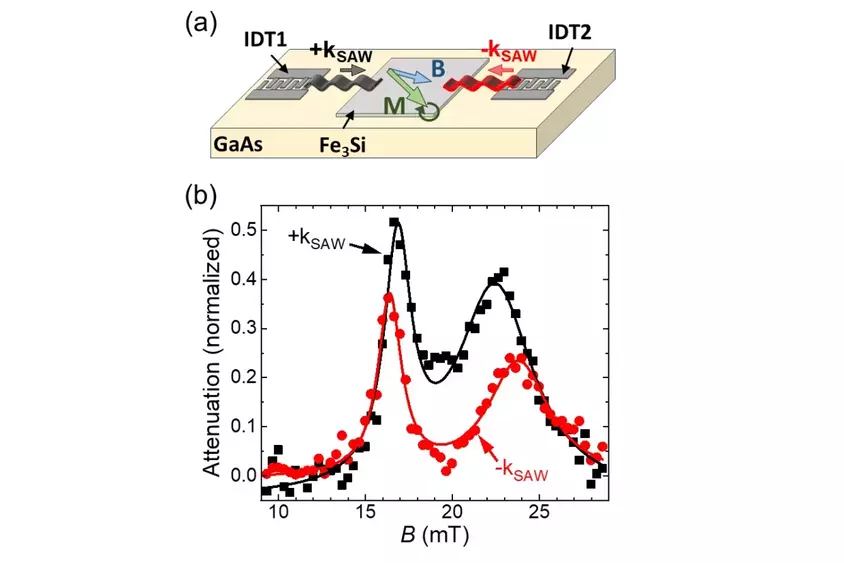Large non-reciprocal propagation of surface acoustic waves in epitaxial Fe3Si/GaAs structures
15.05.2020
Non-reciprocal propagation of sound, that is, the different transmission of acoustic waves traveling along opposite directions, is an essential requirement for the realization of devices such as acoustic isolators and circulators. Here, we demonstrate the efficient non-reciprocal transmission of surface acoustic waves propagating in a GaAs substrate coated with an epitaxial Fe3Si film.
In the last years, there has been an increasing interest in non-reciprocal acoustic systems for the efficient manipulation of sound. Especially appealing are acoustic devices based on surface acoustic waves (SAWs). Due to their efficient piezoelectric generation and detection as well as low propagation velocities, SAWs are successfully applied as on-chip signal processing devices such as radio-frequency filters. In addition to this well-established technology, SAWs are ideally suited for controlling and interfacing elementary excitations in the solid state. Therefore, the on-demand control of SAW propagation by means of non-reciprocal systems represents an important step towards efficient acoustic devices.

In our publication by Hernández-Minguez et al. (1) we demonstrate the non-reciprocal transmission of high-frequency SAWs (3.45 GHz) traveling on a Fe3Si/GaAs hybrid structure grown by molecular beam epitaxy. The non-reciprocity arises from the magneto-elastic coupling between the SAW strain field and spin waves in the ferromagnetic Fe3Si film. For well-defined orientations of the magnetization, the magneto-elastic interaction transfers energy from the acoustic into the magnetic system, thus inducing SAW attenuation. The strength of the attenuation depends on the relative angle between the magnetization and SAW wave vector and can be controlled via the magnitude and orientation of an external magnetic field as illustrated in the figure. The resulting transmission non-reciprocity, defined as the difference between the transmitted acoustic power for forward and backward SAW propagation, reaches values up to 20% under magneto-elastic resonance. These values are, to our knowledge, the largest non-reciprocity reported for SAWs traveling in a semiconducting piezoelectric substrate covered by a ferromagnetic film. The experimental results are well supported by a theoretical model, which shows that non-reciprocity can be further enhanced by optimization of the sample design.
Author: A. Hernández-Mínguez , F. Macià , J. M. Hernandez , J. Herfort , P. V. Santos
Title: Large non-reciprocal propagation of surface acoustic waves in epitaxial ferromagnetic/semicondutor hybrid structures
Source: Phys. Rev. Appl. , 13 , 044018 ( 2020 )
DOI: 10.1103/PhysRevApplied.13.044018